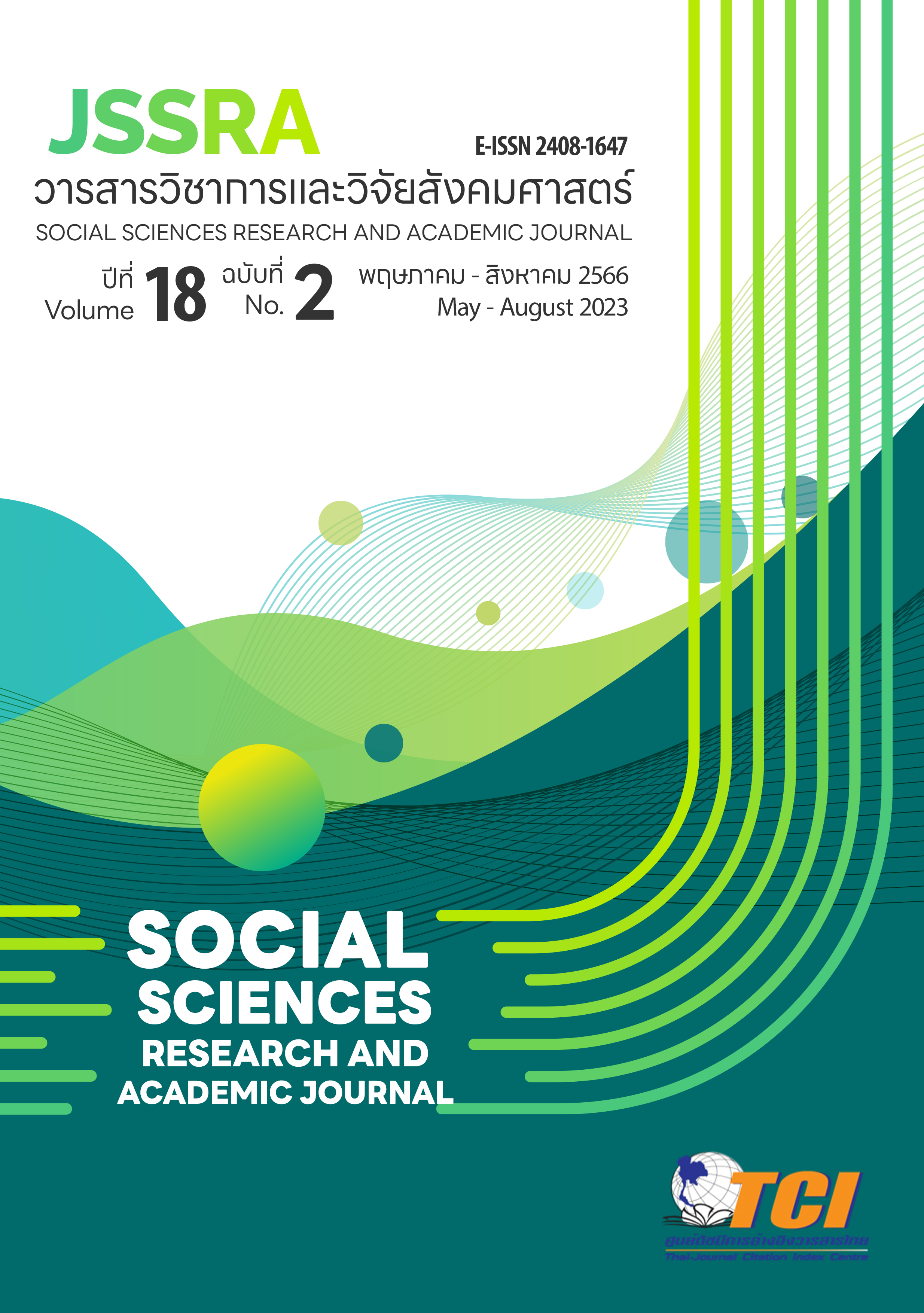อิทธิพลทางตรงและทางอ้อมของการมุ่งเน้นลูกค้า การมุ่งเน้นคู่แข่ง การประสานงานภายใน ที่ส่งผลต่อผลการดำเนินงานของสหกรณ์การเกษตร Direct and Indirect effects of Customer Orientation Competitor Orientation Inter-functional Coordination that effecting on Performance of Agriculture Cooperative*
Main Article Content
Abstract
The objective of this research is to study the direct effect of customer orientation, competitor orientation, and inter-functional coordination which are important factors of market orientation that affect performance and to studying the indirect effect on performance through the innovativeness of agricultural cooperatives. This research is quantitative. The samples are 318 agriculture cooperatives. The questionnaire was used as a tool for this research. The statistics used in this research are confirmatory Factor Analysis and structural equation model analysis. Confirmatory factor analysis, it was found that the measurement pattern was consistent with empirical data and theory. Standard regression weight was found to be between 0.479-0.917. The Composite Reliability (CR) was 0.895-0.964. The Average Variance Extracted (AVE) was 0.607-0.750. Goodness of Fit of the research are CMIN/df = 0.819, df = 2 P = 0.41 CFI=1.000, GFI=0.998, AGFI = 0.985, RMR = 0.003 และ RMSEA = 0.000
The findings of this research are 1) customer orientation, competitor orientation and Inter-functional coordination have a direct effect to performance significantly. 2) customer orientation, competitor orientation, and Inter-functional coordination have an indirect effect on performance through innovativeness significantly at .01 level.
Article Details
References
กรมตรวจบัญชีสหกรณ์. (2563). สารสนเทศน่ารู้ทางการเงิน. สืบค้นเมื่อวันที่ 8 เมษายน 2565, จาก
https://www.cad.go.th>download>information63
กรมส่งเสริมสหกรณ์. (2564). สารสนเทศกรมส่งเสริมสหกรณ์. สืบค้นเมื่อวันที่ 12 ธันวาคม 2564, จาก
https://www.cpd.go.th/index.php
กัลยา วานิชย์บัญชา. (2556). การวิเคราะห์สมการโครงสร้าง (SEM) ด้วย AMOS. กรุงเทพฯ: ห้างหุ้นส่วน
จำกัดสามลดา.
เกรียงศักดิ์ ศรีศิลปวงศ์. (2559). การพัฒนาการบริหารจัดการสหกรณ์การเกษตรของกรมส่งเสริมสหกรณ์
ตามปรัชญาของเศรษฐกิจพอเพียง. วารสารศรีนครินทรวิโรฒวิจัยและพัฒนา (สาขามนุษยศาสตร์
และ สังคมศาสตร์), 8(15), 19-29.
ภัทริกา ชิณช่าง. (2563). ความสามารถทางด้านนวัตกรรมบริการและผลการดำเนินงานขององค์การอย่าง
ยั่งยืน: งานวิจัยเชิงประจักษ์ของธุรกิจโรงแรมในประเทศไทย. วารสารปัญญาภิวัฒน์, 12(1), 15-29.
มนัสนันท์ ใบคุณากร.(2563). อิทธิพลขององค์กรแห่งการเรียนรู้ต่อผลการดำเนินงานขององค์กรผ่าน
พฤติกรรมสร้างสรรค์นวัตกรรมของพนักงานธนาคารเพื่อการเกษตรและสหกรณ์การเกษตร.
วิทยานิพนธ์บริหารธุรกิจมหาบัณฑิต (สาขาบริหารธุรกิจมหาบัณฑิต). มหาวิทยาลัยศิลปากร,
นครปฐม.
ลัดดาวัลย์ เพชรโรจน์ และอัจฉรา ชานิประศาสน์. (2547). ระเบียบวิธีวิจัย. กรุงเทพฯ: พิมพ์ดี.
อุบลวรรณ สุวรรณภูสิทธิ์ และอำพล ชะโยมชัย (2561). นวัตกรรมและผลกระทบต่อผลการดำเนินงาน
ของกิจการหนึ่งตำบลหนึ่งผลิตภัณฑ์ (โอทอป) ในประเทศไทย.วารสารวิชาการ มหาวิทยาลัย
หอการค้าไทย มนุษยศาสตร์และสังคมศาสตร์, 38(1), 18-35.
อนุวัต สงสม. (2562). ผลของความสามารถทางนวัตกรรมที่มีต่อความได้เปรียบทางการแข่งขัน สำหรับ
วิสาหกิจขนาดกลางและขนาดย่อมในจังหวัดสงขลา. Veridian E-Journal: Silpakorn University,
(3), 821-834.
Acar, Z.A. & ÖZŞahi, M. (2018). The relationship Among Strategic Orientation, Organizational
Innovativeness, and Business Performance. International Journal of Innovation Management,
(1), 1-27.
Acikdilli, G. (2013). The Effect of Marketing Capabilities and Export Market Orientation on Export
Performance. Interdisciplinary Journal of Contemporary Research in Business, 5(6), 30-59.
Alhakimi, W. & Mahmoud, M. (2020). The impact of market orientation on innovativeness: evidence
from Yemeni SMEs. Asia Pacific Journal of Innovation and Entrepreneurship, 14(1), 47-59.
Asheq, A.A. & Hossain,Md.U. (2019). SME Performance: Impact of Market, Customer and Brand
Orientation. Academy of Marketing Studies Journal, 23(1). 1-9.
Baykal, E., Zehir, C. & Kole, M. (2018). Effects of Servant Leadership on Gratitude, Empowerment,
Innovativeness and Performance: Turkey Example. Journal of Economy Culture and Society,
, 29-52.
Debruyne, M., Frambach, R.T. & Moenear, R. (2010). Using the Weapons You Have: The Role of
Resources and Competitor Orientation as Enablers and Inhibitors of Competitive Reaction to New Products. Journal of Product Innovation Management, 27(2), 161 – 178.
Deshpandé, R., Farley, J.U. & Webster, F.E. (1993). Corporate Culture, Customer Orientation, and
Innovativeness in Japanese Firms: A Quadrad Analysis. Journal of Marketing, 57(1), 23-37.
Distanont, A. and Khongmalai. (2020). The role of innovation in creating a competitive advantage.
Kasetsart Journal of Social Sciences, 41, 15–21.
Domi, S, Capelleras, J.L. and Musabelliu, B. (2020). Customer orientation and SME performance in
Albania: A case study of the mediating role of innovativeness and innovation behavior. Journal of Vacation Marketing, 26(1), 130-146.
D’souza, C., Nanere, M., Marimuthu, M., Arwani, M. & Nguyen, N. (2021). Market orientation,
performance and the mediating role of innovation in Indonesian SMEs. Asia Pacific Journal of Marketing and Logistics, 1-17.
Fornell, C. & Larcker, D.F. (1981). Evaluating structural equation models with unobservable variables
and measurement error. Journal of Marketing Research, 18(1), 39-50.
Ho, K.L.P., Nguyen, C.N., Adhikari, R., Miles, M.P. & Bonney, L. (2018). Exploring market orientation, innovation, and financial performance in agricultural value chains in emerging economies. Journal of Innovation & Knowledge, 3(3), 154-163.
Hult, G.T.M., Hurley, R.F. & Knight G. A. (2004). Innovativeness: Its antecedents and impact on
business performance. Industrial Marketing Management, 33, 429-438.
Johnson, A.J., Dibrell, C.C. & Hansen, E. (2009). Market Orientation, Innovativeness, and Performance of Food Companies. Journal of Agribusiness, 27(1/2), 85-106.
Kirca, A.H., Jayachandran, S., & Bearden, W.O. (2005). Market Orientation: A Meta-Analytic Review
and Assessment of its Antecedents and Impact on Performance. Journal of Marketing, 69(2), 24-41.
Mahmoud, M.A., Blankson, C.,Owusu-Frimpong, N., Nwankwo,S and Trang T.P. (2016). Market orientation, learning orientation and business performance: The mediating role of innovation. International Journal of Bank Marketing, 34(5), 623-648.
Masa’deh,R., Henzab, J.I., Tarhini,A. & Obeidat, B.Y. (2018). The associations among market
orientation, technology orientation, entrepreneurial orientation and organizational performance. Benchmarking: An International Journal, 25(8), 3117-3142.
Milani, A.M. & Salavati, S. (2018). The role of Market Orientation and Innovation in Improving
Business Performance of the Banking Industry. European Journal of Sustainable Development, 7(4), 556-571.
Mubarak, K.M. (2019). Impact of customer & Competitor Orientation and Inter-functional Coordination
on SME’s Performance. Journal of Management, 14(2), 88-94.
Narver, J.C. & Slater, S.F. (1990). The Effect of a Market Orientation on Business Profitability. Journal
Of Marketing, 54(4), 20-35.
O’dwyer, M., & Gilmore, A. (2017). Competitor orientation in successful SMEs: an exploration of the impact on innovation. Journal of Strategic Marketing, 27(1), 21-37.
Santos, M.J., Perin,M.G., Simões, C. & Sampaio, C.H. (2020). Customer orientation and financial
performance relationship: the mediating role of innovative capability. Gest & Prod, 27(4), 1-20.
Sarker, S & Palit, M. (2015). Strategic orientation and performance of small and medium enterprises in
Bangladesh. International Journal of Entrepreneurship and Small Business, 24(4), 572-586.
Sukato, N & Terason, S. (2021). Innovativeness in the Chinese Hotel Industry as Affected by Social
Networking Site Behavior and Customer Orientation. Asia-Pacific Social Science Review, 21(2), 75-89.
Schulze, A., Townsend, J.D. & Talay, M.B. (2022). Completing the market orientation matrix: The
impact of proactive competitor orientation on innovation and firm performance. Industrial Marketing Management, 103, 198-214.
Yadav,S.K., Tripathi, V. & Goel, G. (2019). Mediating effect of innovation with market orientation and
performance relationship. Journal of the Iberoamerican Academy of Management, 17(2), 152-167.


